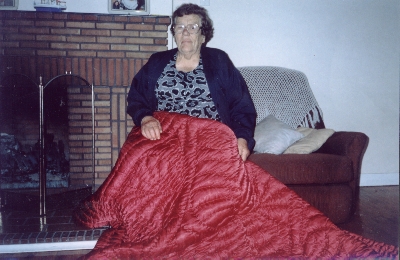Quilt No.566AM - Alexandra Magloveris
2300 x 1700mm
Alexandra chose the satin and had the quilt made on the island of Kephallonia in 1952. She has always owned it. It is not used now.
"A Quilt from Kephallonia
When Alexandra Magloveris knew she would be coming to Australia in 1956, she paid the local 'paplomatas (quiltmaker), the equivalent of $A30 to make her 'paploma' (quilt). She chose the beautiful satin cloth in two shades of wine red. The wool used as padding was grown on the island of Kephallonia, the largest of the Ionian islands on the western side of Greece.
During the time when Alexandra was growing up, it was not uncommon for Greek girls to be married very young, and at fourteen Alexandra was married to Dionysis, they went on to have two children. This was during the WW2 years and young Dionysis having already spent time fighting with the Greek army, had returned home to organise his passport. Sadly, he was tragically killed through treading on a landmine in Kephallonia.
Although Alexandra found life extremely difficult as a young widow, she vowed never to marry again. As Greece emerged from the ravages of war, the country was engulfed by a bitter civil war, and it was at this time that Alexandra and her sons George and Steve migrated, with the assistance of Dionysis' brother who had come to Australia a few years earlier.
For Alexandra, arrival in Australia was not the positive experience it has been for so many others:
' When we arrived at Circular Quay and I saw the houses with rusted
iron roofs�..I was so upset. It was all so ugly. We left earthquakes
and poverty to come to something better�.but it was terrible. I
wanted to go back!'
At first they lived in one room in a Paddington boarding house. As an attractive young widow in the Sydney of the 1950's and 60's, Alexandra was often at risk for her personal safety. But she persevered and worked hard to house and educate her children, and to make the best of her life in this very different country.
Alexandra's 'paploma' has never been used and is still in near new condition. It remains as a symbol of her journey of life and migration in difficult times and circumstances."
[Written by Lula Saunders; adapted from interview 3/1/98, for the National Quilt Register]
Related Quilts:
2070 x 2000mm
2360 x 2310mm
2200 x 1840mm
1750 x 840mm








